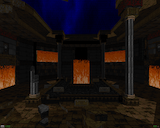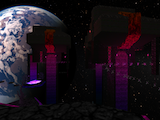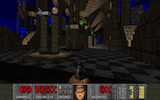|
Top Ten - Page 3
Legacy of Heroes
- Gaspe

 Perhaps the most magical thing about Legacy of Heroes, aside from the fantasy setting and the fact that it features in the Cacowards at all, this year (it was released in early November of 2016), is the quality of craftsmanship on display and how it belies the inexperience of its author. Lofty ambition can be a problem for new artists in any pursuit, and if it finds you reaching for the heights of, say, Eternal Doom... well, I pray you have a firm grasp of the editor. Team Eternal's epic is a partial conversion that is so mired in criticism for its dirge-like combat and progression, while also appreciated for some nebulous thing that is seemingly inseparable from that problem, that capturing the heart of it could be considered a bold move even for veteran level designers. Gaspe started Legacy just two months after joining the community in 2015, so his success should give you an idea of how talented he is, as well as the quality of the episode on offer.
Perhaps the most magical thing about Legacy of Heroes, aside from the fantasy setting and the fact that it features in the Cacowards at all, this year (it was released in early November of 2016), is the quality of craftsmanship on display and how it belies the inexperience of its author. Lofty ambition can be a problem for new artists in any pursuit, and if it finds you reaching for the heights of, say, Eternal Doom... well, I pray you have a firm grasp of the editor. Team Eternal's epic is a partial conversion that is so mired in criticism for its dirge-like combat and progression, while also appreciated for some nebulous thing that is seemingly inseparable from that problem, that capturing the heart of it could be considered a bold move even for veteran level designers. Gaspe started Legacy just two months after joining the community in 2015, so his success should give you an idea of how talented he is, as well as the quality of the episode on offer.
Comparisons can be made between Legacy and Shadows of Cronos, by Kaiser, a cacoward-winning hub for Hexen that distils the finer qualities of that game into a more immediately enjoyable experience. Whereas Cronos limits the many strands of progression for accessibility, however, Legacy continuous to embrace the polarising nature of Eternal Doom's adventure—at least to some extent—so as to capture that "nebulous something" more truly, all the while providing the sorts of tasteful and challenging encounters you would expect to see in more refined modern works. This isn't too surprising given Gaspe's single contributions to TNT: Revilution and Devilution, which take advantage of an allowance for more representational and off-kilter design to create something narrative-driven.
The world of Legacy is something to behold, as well (important, if you plan on getting lost!). For many, this is the crux of Eternal Doom's majesty and the reason why its resources continue to enjoy use in works like THT: Threnody and Dark Tide. Decorated courtyards and castles and ruins. Ancient things, mysterious things. All familiar themes to the well-traveled player but crafted here with an evident fondness and attention to detail, and combining with the sense of scale and journey to make a firm impression on the player.
It's a rare thing for a new talent to reveal itself so completely in a community as diverse as this; not to lose sight of an idea that is unspoiled by sensibilities because of some navigational problem, or a premature understanding of what makes the game fun. With Legacy of Heroes, Gaspe has not only avoided these issues but found his element. Frankly, I'm not sure whether to get teary-eyed or turn green with envy.
I think I'll just play the whole thing again to calm down.
- Alfonzo
Saturnine Chapel
- dobu gabu maru

 "I write of sorrow, I write of things most ill..."
"I write of sorrow, I write of things most ill..."
Emerging from beyond the wall of sleep early this year, Dobu Gabu Maru's Saturnine Chapel is perhaps most immediately notable for its nightmarish encounter design. An early period of deliciously ominous silence soon erupts into one of a selection of point-blank introductory bloodbaths where the difference between survival and being deboned like a fish is measured in centimeters and seconds, and the ante is steadily upped over the duration, culminating in a harrowing melee in a lacquered coffin requiring nerves of steel and, perhaps, a change of sheets once the dream ends. Yet, the elapsed time between these two points is deceptively short; a clean run from start to finish is potentially well under ten minutes long, and in that brief span the level fields a smorgasbord of setpiece battles as imaginative as they are deadly, ranging from a purely defensive waltz through a hail of fire amidst ephemeral cover in an elevated cupola to a brilliant dance of death with a cyberdemon (or a pair, if one is truly dreaming deeply) in a baptismal drowning pool which lends new meaning to the phrase 'choreographed fight.'
For all of the visceral power of its uncomfortably intimate battles, however, the Chapel is equally arresting as a visual piece and as a setting, depicting an elaborate gothic tower floating in an incandescent poison swamp, housing a tight-knit nest of ornate reading rooms, dungeon chambers, ooze-cisterns, and bizarre altars, all rendered in fine detail, each possessing an odd sort of baroque beauty. Wherever one wanders in the Chapel or its grounds, there's something interesting to see, and as a piece of technical mapcraft the work is second to none. There's much more on offer here than a hardworked visual presentation, though; the dream leaves a lingering impression long after morning has come, via a very distinctive artistic voice, a sense of style that instills the Chapel (like Dobu's other noteworthy maps this year) with a certain eerie gravitas.
The devil is very much in the details in this case. Unusually belligerent dreamers, for instance, will hear a deafening roar in the distance upon shaking their fists at the glowering sky, only for all to immediately sink back into sinister silence. The more time one spends wandering the grounds, the more obvious it becomes that inorganic materials like metal and stone are shaped and behave as organic ones, while organic materials are often dead and stark in implementation. One particularly striking conceit is that there's never a clear distinction between up and down in the construction and connecting logic of the Chapel's various rooms, or indeed in that of the entire pocket dimension it inhabits, and progression through its gauntlet of horrors seems to playfully nod at this throughout, with many of the deadliest encounters being driven as much by uncanny shifts in the environment as by the monstrous parishioners themselves.
None of this is accidental--Dobu builds each of his creations upon a bedrock of unstated backstory, and leaves the player to glean what they can about each of his strange settings from his/her own sojourns within them, elevating the experience beyond the level of exploring an attractive Doom level to partaking in a small glimpse of some other world, of Things Not Yet Seen. Saturnine Chapel, then, is a fine outing for that particular sort of player that enjoys pondering lore while pounding on demons, and indeed, there are many intriguing mysteries and hints and hidden implications in Saturnine Chapel for those willing to dig deep into its strange pith... and all of this from a level which uses only stock textures, to boot, once again reminding us all of how far a bit of imagination can take design for a game now well over 20 years old.
-Demon of the Well
Stardate 20x7
- Ribbiks

 *checks calendar* Oh, look! It's a year ending with an odd numeral, that means it's time to hand Ribbiks another Cacoward or two!
*checks calendar* Oh, look! It's a year ending with an odd numeral, that means it's time to hand Ribbiks another Cacoward or two!
Stardate 20x7 is a 11-map set that revisits the purple theme of its 2013 prequel, but that's where the similarities end, because Ribbiks 2017 is quite a different beast. No longer paying homages to Sunder, the oppressive brutalist architecture of brown and grey is all but gone, and those purple stripes of yesteryear took over the entire show. Somewhat ironically this wad looks more like a follow-up to Ribbiks' other 2013 Cacoward winner, Swim with the Whales, where the dark violet wasn't just a highlight colour, but a structural one. Except now we find ourselves another step further, and the blacks, browns and greys become highlight colours in a sea of blinking and dramatically shadowed purple.
Similarly to the colour evolution, the architecture itself also feels more otherworldly, abstract and generally curvy. Ribbiks seems to have grown comfortable in impressive over oppressive, and be it vaguely Oriental villages in a purple sea, purple techbases hovering in the void, more techbases in purple caverns, or purple temples of the God of Purple, it is all gorgeous eye-candy and shameless screenshot bait. It must feel great to be so confident in your art style that you can chaotically hop between architecture styles, yet create a thematically consistent set with an unmistakable identity.
On the gameplay side of the equation, Ribbiks has mellowed out a little, or perhaps embraced the mainstream just a bit more. His older wads were nightmare fuel for anyone but an elite bunch of masochistic players, in part because of the complete lack of difficulty settings, but the widespread success of Sunlust and its careful dip into the waters of skill balancing seems to have convinced Ribbiks to cater to the more casual player as well. With the intended balance on Hurt Me Plenty, the wad is "merely" a challenge-oriented mapset that kills you a lot, but even the cruelty-oriented UV balance is more about figuring out how to tackle fights than the tapdancing tests of the prequel. This is the most approachable Ribbiks wad yet, folks.
There has been some grumbling among us that the wad is technically nothing all that new, just Ribbiks honing his trade and delivering yet another polished masterpiece. Shouldn't something brand new and different get awarded instead? But at least for now, the answer is no. As long as Ribbiks keeps maturing, improving and having fun with his mapping, he will be hoarding the trophies.
-dew
Void and Rainbow
- Serious_MOod

 There's an ongoing joke over at the ZDoom forums; when someone posts a palette swapped version of a sprite, someone inevitably reproduces the same illustration five additional times—one for every color in the chromatic spectrum—and subsequently posts a seizure-inducing animated gif cycling maddeningly though every color of the rainbow. Watching these animations is an affront to your visual senses, so it's completely anathema to me that Serious_MOod saw this Fruity Pebble effect and said to himself "I'm going to make an entire map out of flashing ROYGBIV textures." Even crazier? It works.
There's an ongoing joke over at the ZDoom forums; when someone posts a palette swapped version of a sprite, someone inevitably reproduces the same illustration five additional times—one for every color in the chromatic spectrum—and subsequently posts a seizure-inducing animated gif cycling maddeningly though every color of the rainbow. Watching these animations is an affront to your visual senses, so it's completely anathema to me that Serious_MOod saw this Fruity Pebble effect and said to himself "I'm going to make an entire map out of flashing ROYGBIV textures." Even crazier? It works.
Void & Rainbow is a spiritual successor to Cyb's seminal 2003 release, Void, with its own unique take on the surreal. As the name implies, Void & Rainbow's defining feature is the largely monochromatic environment accented liberally with animated textures and sprites that cycle between the entire spectrum of visible colors. Serious_MOod, as I wrote earlier, managed to make this garish concept aesthetically pleasing; it's surprisingly beautiful and a creative twist to the Void theme other maps have attempted to emulate.
Complementing the map is an entirely new, yet familiar, arsenal of weapons and creatures from the Realm667 bestiary. The weapons are creative variants of those found in Doom 64, while the monsters were chosen to specifically compliment the unique layout of the map. Despite minor changes to the gunplay, some new variations on monsters, and completely revamped jumping physics, the level still feels remarkably "Doom." The new jumping physics make the gameplay more Doom 2016, and help fix one of the major problems with this map's inspirational parent, Void.
There's so much to love about Void & Rainbow; the Skittles-themed aesthetic, the tweak on classic Doom gameplay, the exploration of a sprawling level, and the plethora of new artwork really sell the map. Serious_MOod has crafted a contemporary and unique spinoff from the original Void that, in many ways, improves on the original formula. Four Flippers.
-Scuba Steve
|
2017 Cacowards
Espi Award for Lifetime Achievement
Top Ten - Page 1
- lilith.pk3
- Shadows of the Nightmare Realm
- No End in Sight
Top Ten - Page 2
- Dead.air
- Brigandine
- Counterattack
Top Ten - Page 3
- Legacy of Heroes
- Saturnine Chapel
- Stardate 20X7
- Void and Rainbow
Multiplayer Awards
- Pyrrhic
- Progressive Duel 2
Gameplay Mod Awards
- Doom Delta
- Final Doomer
- High Noon Drifter
Other Awards
- Codeaward
- Mordeth Award
Mockaward - Mapper of the Year
RUNNERS UP: THE THREEQUEL
Water Spirit - Manbou

"Water Spirit" is the solo debut of Japanese mapper Manbou (aka burabojunior), of last year's notable JPCP. A treat for the senses from the outset, the beautiful vistas of astral palaces amidst great skybound lagoons found herein might perhaps call to mind the flavor of the "blue period" of a certain Western mapping phenom of some renown, but the more fantastical tone ultimately makes for a sojourn that's less an impenetrable azure nightmare and more of an enveloping blue dream.
Not to say it's a particularly placid dream, mind you. Indeed, each of the three levels is awash with monsters of all shapes and sizes, and Manbou has seen to it that the initial trickle of opposition in each will soon explode into a tidal wave of evil more than deep enough to drag you under if you don't get to paddlin', and fast. That being said, however, despite the ever-escalating bodycount, Water Spirit's opulent grottoes and porticoes are more playground than drowning pool, amenable to a wide variety of different strokes in skill and playstyle, a refreshing splash of that joyous marriage of fluid motion and combat which is so uniquely Doom.
Hellscape - Chris Lutz

Chris Lutz is indubitably one of the past masters of that evergreen mapping tradition of remaking, repurposing, or otherwise re-imagining the classic IWAD levels. With "Hellscape", he returns to a project innocuously begun in 2007 with "The Dying End", an ornate revisiting of Doom II's original MAP29. Hellscape sees the rest of Doom II's third episode given the same treatment and then some, not simply supplying an aesthetic makeover but fully recreating these classic designs from the ground up in the lavish, occasionally breathtaking detail which is Lutz's calling card. Each of these ten maps, while immediately recognizable to veterans of the original game, also work as fresh experiences; progression paths are fleshed out and cinematically contextualized, and marquee combat encounters are bolstered with additional slavering cannon fodder, always with the aim of doubling down on dramatic spectacle. The result is an immersive journey at once new and yet eerily familiar, standing as one of the most compelling realizations to date of that subtly melancholy aura of ruinous decay which so distinguishes Doom II's endgame from the more lurid fire-and-brimstone angle of its predecessor.
Dark Tide - Chris Lutz

With "Dark Tide", Lutz pays a fond homage to Sverre Kvernmo's "Darkdome" (MAP12 of Eternal Doom) in the form of a majestic castle squatting on a low promontory in a lovely seaside inlet. To say that the place is a beauty to behold and a pleasure to explore would be an understatement; stately courtyards, grand halls, ornate chapels, dank cisterns, a hidden harbor, flying buttresses over sweeping battlements, and sundry other architectural delights await you, making for one of the most well-realized Doom Locations (TM) this year, D_RUNNIN aside ;) .
None of this should come as a surprise, of course; this kind of thing has long been Lutz's stock in trade. What's more unexpected is that the castle is initially shrouded in a disarmingly potent blanket of flying lead, prompting a dicey charge across open ground into the relative safety of the foyer, with the path branching out in many possible directions from there. This increased sense of peril in combination with one of the most truly non-linear layouts of Chris's career makes for a map that's equally appealing as a sightseeing tour and as an opportunity to "get medieval."
|

